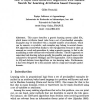93 search results - page 3 / 19 » Homology Induction: the use of machine learning to improve s... |
SLP
1989
13 years 7 months ago
1989
This paper describes a learning system, LASSY1, which explores domains represented by Prolog databases, and use its acquired knowledge to increase the efficiency of a Prolog inter...
BMCBI
2005
13 years 5 months ago
2005
Background: Profile hidden Markov model (HMM) techniques are among the most powerful methods for protein homology detection. Yet, the critical features for successful modelling ar...
ECML
1993
Springer
13 years 10 months ago
1993
Springer
This paper describes a genetic learning system called SIA, which learns attributes based rules from a set of preclassified examples. Examples may be described with a variable numbe...
ICASSP
2007
IEEE
14 years 3 days ago
2007
IEEE
Protein structure prediction aims to determine the three-dimensional structure of proteins form their amino acid sequences. When a protein does not have similarity (homology) to a...
BIOINFORMATICS
2005
13 years 5 months ago
2005
Motivation: Remote homology detection between protein sequences is a central problem in computational biology. Supervised learning algorithms based on support vector machines are ...

